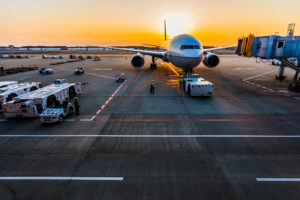
2020 was the year when borders were closed, flights were grounded, and traveling was mostly limited to the confines of our homes. As the pandemic began to spread globally, the air industry came to a grinding halt by March. Needless to say, it was the worst year for the aviation industry, which profits from people leaving their houses. According to the International Civil Aviation Organization, airlines across the globe suffered a staggering loss of around 392 billion dollars in 2020, and it may take years to reverse the damage.
Initially, when the commercial flights were restarted, the fear of catching the infection from the air that circulated inside the aircraft and being quarantined at a hotel while away from home, prevented many of us from going far at all. But, as more people are getting vaccinated, people’s interest in travel has gone up. About 95 percent of travelers are eager to travel as soon as the travel restrictions are lifted, and 54 percent believe it is not very risky to travel abroad right now, despite the rise of variant cases, says a recent survey conducted by SchengenVisaInfo.com.
But, how safe is traveling yet? With the spread of the virus and its mutation all across the world, how will the future of traveling look like, and what changes can travelers expect in the coming days? We sat down with Dr. Bishal Dhakal, Founder, Health at Home/Med pro International Pvt. Ltd, and talked about how the post-pandemic travel could look like with his extensive interest in travel medicine.
At one point, he says, around one billion people were traveling at any given time, and it itself was the biggest population on the move. And, to bring the industry about the size of the continent to a standstill had a big impact on the global economy and the whole processes associated with it. “So, getting it back was inevitable for humanity, and we started off with cargo.”
He says that cargos were the front liners that exchanged a lot of commodities from flights and transports in the early days. In the next phase, the institutions related to the logistic part slowly reinvigorated the platforms for logistic teams, flight crews, and hotels. Then, the distribution networks of the supply chain began opening up with the help of humanitarian organizations. Next were the businesses and opportunists, who began flying in and out.
Recently, he says he is seeing a new trend of risk takers. They are the people who are bold enough to take advantage of the lower rates and good deals on itineraries and flying. So, a different kind of tourism is evolving in the post-pandemic world, he says. “In general, we are seeing a shift in global trends, including in education, health, and also travel. But, how they will all be shaped, only time will tell.”
Now, he says,there will be new protocols like travel passports and all the processes of travel will be realigned according to the post-pandemic situation. “And, it will gives us an opportunity to rethink about our own protocols, which I think are on the right track,” he adds.
In fact, many countries are coming up with a proposal for some kind of vaccination passport, which is a documented proof of being vaccinated. At present, many countries are still closed to international travelers. But, many of them are also willing to accept people who are either vaccinated, or have proof that they are not carrying a virus through a test right before they travel.
People, however, seem to have different opinions about the traveling rules and restrictions. According to the survey by SchengenVisaInfo.com, 62 percent of travelers believe that testing upon arrival is the best way to prevent the spread of COVID-19, 43.35 percent think COVID-19 vaccination should be made obligatory for travel, and 58.65 percent believe it is not a good idea to impose such a requirement. Currently, a negative PCR test result within 48 to72 hours before arrival, and quarantines upon entry for up to 10 days for t hose coming from another region and country, followed by another negative test result in a few days, are some of the travel requirements enforced by different countries.
So, the only way to get international travel to start up again is when more people are vaccinated and governments feel it is safe to travel. And, for those who are making plans, the health and safety initiatives at airports and abroad aircrafts will definitely impact people’s decision to travel.
Many aircrafts, today, like Turkish Airlines, are taking extra measures to ensure the hygiene and safety of passengers. Besides obligatory things like wearing a mask, maintaining physical distance of at least 1.5 meters, using hand sanitizers, fever checks, protective panes, no-contact check-in, and automated check-in at airports, Turkish Airlines has collaborated with Health at Home/Med pro International Pvt. Ltd. to provide a free PCR test for Business Class passengers in the comfort of their home and discounted PCR rates for Economy Class passengers to facilitate the new traveling requirements for its clients. Such testing provided by the airlines will certainly make traveling much easier, as people begin to travel again.
To boost people’s confidence, airlines are also frequently saying that commercial planes are equipped with HEPA filters that capture 99.97% of airborne particles and substantially reduce the risk of viral spread.
Further delving into the new trends in traveling, Dr. Dhakal predicts that mass travel will be extinct in due course of time and luxury and boutique travels will take its place. “People are not very excited about going on an economy class or a group, because these kinds of pandemic are going to be a regular scene now,” he says, adding, “it’s a prophecy, but it’s going to be there.”
So, how can we make traveling safer, or should we just forget about traveling at all? He says, “We will be paying more, we will be safer more, and we will be traveling more frequently in the future. There will be more travel with smaller private group tours. We will vet around our close bubbles, create our own kind of ecosystem, and we’ll try to be as safe as possible. Instead of directly flying to Turkey, maybe we will pay around $20,000 dollars for a jet and fly in our own flight with a group of 7-10 people.”
Despite the spread of the contagious new variants, he is optimistic and even anticipates about the new innovations in the aviation sector. “We will probably have 20-30 aircrafts hanging around in Kathmandu as a local transport as taxis for people to fly long hauls on those jets. It’s a very interesting concept,” he says, adding, “amidst all the inventions that are taking place, we might even have airlines with encapsulated cabins in future. There can be very interesting engineering innovations inside the aircraft to cater to our safety needs.”
“But, mass travel will definitely go down. Even if it exists, it will be very different,” he concludes.
 Medicosnext
Medicosnext




